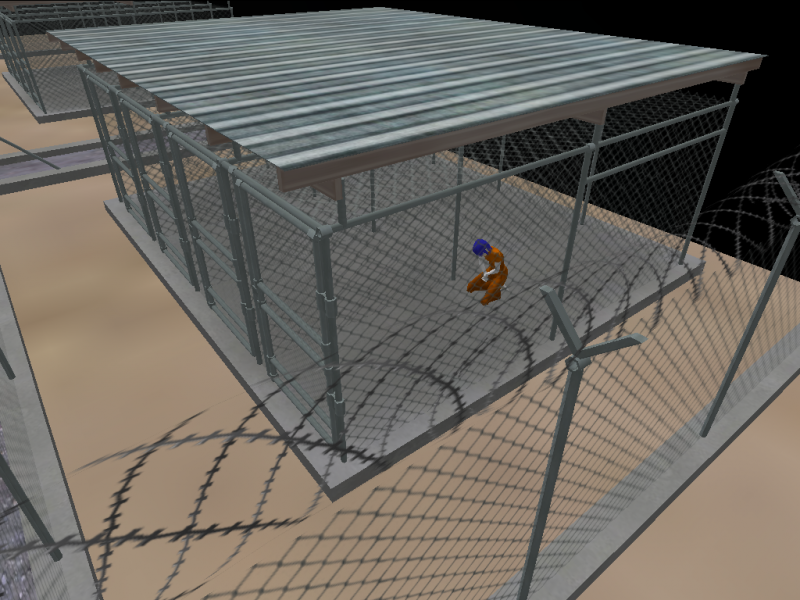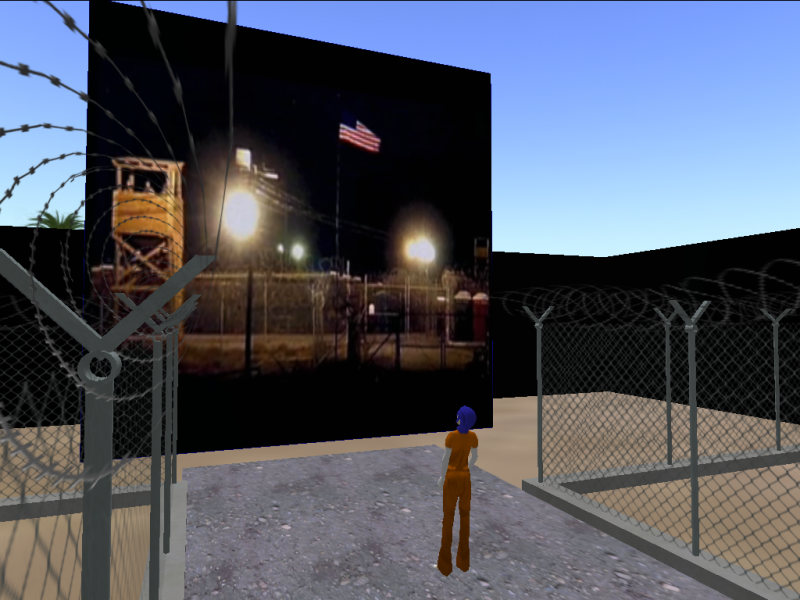- Introduction to the Issue
- Whose Literacy Is It Anyway? Examining a First-Year Approach to Gaming Across Curricula
- Computer Games Across the Curriculum: A Critical Review of an Emerging Techno-Pedagogy
- What Games Have to Teach Us About Teaching and Learning: Game Design as a Model for Course and Curricular Development
- Four Ways to Teach with Video Games
- Life in Morrowind: Identity, Video Games, and First-Year Composition
- Stings and Scalpels: Emotional Rhetorics Meet Videogame Aesthetics
- The Avatar that therefore I Am (Following)
- Machinima-to-Learn: From Salvation to Intervention
- Procedural Rhetorics / Rhetoric's Procedures: Rhetorical Peaks and What It Means to Win the Game
- Gone Gitmo: An Interview with Co-Creators Nonny de la Peña and Peggy Weil
- Serious Games Interactive Interview
- Contributors' Notes
Gone Gitmo: An Interview with Co-Creators Nonny de la Peña and Peggy Weil
On Friday, March 26, Charlotte Nunes, Currents editorial committee member, interviewed Nonny de la Peña and Peggy Weil, co-creators of Gone Gitmo, a virtual installation of the Guantánamo Bay detention facility on Second Life. Their collaboration began in 2007. Peggy Weil is currently a digital media artist teaching at the California College of the Arts in San Francisco. She was formerly a professor for many years at the University of Southern California’s Interactive Media Division. Nonny de la Peña is a Senior Research Fellow in Immersive Journalism at the Annenberg School of Communications and Journalism at the University of Southern California. Below is an introductory clip to Gone Gitmo, courtesy of Bernhard Drax (soundsgood@bernharddrax.com).
Charlotte Nunes: The theme of this issue of Currents is “Gaming Across the Curriculum: Playing as a Way of Learning.” Could you provide some background on the collaborative development of Gone Gitmo? How do you conceptualize the term “serious gaming,” and the relationship between “play” and “learning”? What are some ways to conceptualize gaming as a pedagogical tool? How does “serious gaming” differ from unserious gaming? Is the difference a function of the game or the gamer?
Currents Clip 7 from DWRL on Vimeo.

Charlotte Nunes: The relationship (if any!) between gaming and narrative has inspired a good deal of debate in the academic community. Do games tell stories? If so, how? What kinds of stories can or do games tell? And how can games tell them in a way other forms or media cannot?
Currents Clip 1 from DWRL on Vimeo.
Currents Clip 2 from DWRL on Vimeo.
Currents Clip 6 from DWRL on Vimeo.

Charlotte Nunes: “Fun” can only happen with a particular degree of freedom; it requires a certain lack of structure, while “learning,” or the straightforward provision of information, instead necessitates structure and direction. How must games simultaneously appeal to players and teach them? In what ways can and do developers negotiate a tension between structured learning and unstructured play?
Currents Clip 8 from DWRL on Vimeo.
Charlotte Nunes: Related to the idea of structure, part of the joy of games lies in our outsmarting them: in learning a “cheat,” developing a hack, or altering a structured system in ways not necessarily intended by their developers. Is using a given structure in new ways (e.g., Gone Gitmo in the space of Second Life) at all similar to testing the limits of a game? Can the phenomenon of "game-breaking" be taken into account within game design, or channeled on the behalf of learning? How do players use games to learn in ways beyond the provided structure of the game itself? And can the developer-gamer relationship be one of two-way learning?
Currents Clip 5 from DWRL on Vimeo.

Charlotte Nunes: Games work because they affect us; they make us feel. How does tapping in to the player experience also mean connecting to the gamers’ emotions, and providing (as one submitter’s article puts it) “a particular mediated emotional skill-set”? Are there limits to this, or potential risks? How might the kinds of feelings evoked in online or gaming environments effect other life situations? What productive benefits can such pedagogy encourage; and, conversely, do you see any dangers or potentially negative effects in these kinds of learning communities?
Currents Clip 4 from DWRL on Vimeo.
Further links (courtesy of Peggy Weil):
A video documentary of the Gone Gitmo project is here:
The SLURL (Second Life URL) to the Gone Gitmo site is here:
A blog about the site, including links to press and publications, is here:


